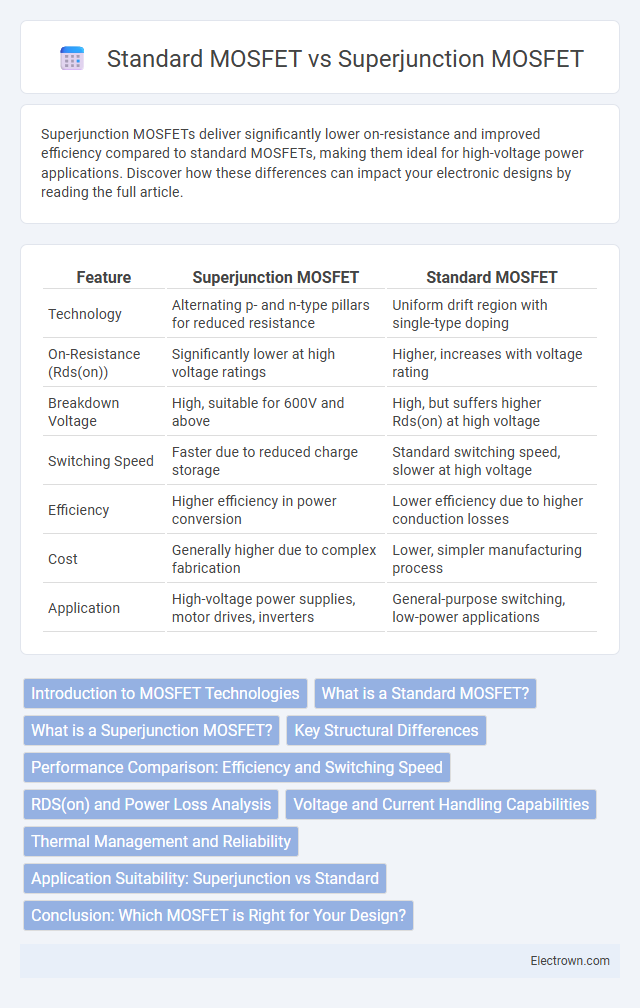Superjunction MOSFETs deliver significantly lower on-resistance and improved efficiency compared to standard MOSFETs, making them ideal for high-voltage power applications. Discover how these differences can impact your electronic designs by reading the full article.
Table of Comparison
| Feature | Superjunction MOSFET | Standard MOSFET |
|---|---|---|
| Technology | Alternating p- and n-type pillars for reduced resistance | Uniform drift region with single-type doping |
| On-Resistance (Rds(on)) | Significantly lower at high voltage ratings | Higher, increases with voltage rating |
| Breakdown Voltage | High, suitable for 600V and above | High, but suffers higher Rds(on) at high voltage |
| Switching Speed | Faster due to reduced charge storage | Standard switching speed, slower at high voltage |
| Efficiency | Higher efficiency in power conversion | Lower efficiency due to higher conduction losses |
| Cost | Generally higher due to complex fabrication | Lower, simpler manufacturing process |
| Application | High-voltage power supplies, motor drives, inverters | General-purpose switching, low-power applications |
Introduction to MOSFET Technologies
Superjunction MOSFETs utilize a unique multi-layered structure with alternating p-type and n-type regions, significantly reducing on-resistance and improving efficiency compared to standard MOSFETs. Standard MOSFETs rely on a single uniform drift region, which limits their performance in high-voltage applications due to higher conduction losses. The advanced superjunction design enables enhanced switching speed and thermal management, making it ideal for power electronics requiring high voltage and low conduction losses.
What is a Standard MOSFET?
A Standard MOSFET (Metal-Oxide-Semiconductor Field-Effect Transistor) is a widely used semiconductor device designed for switching and amplification in electronic circuits. It operates by controlling the voltage applied to the gate terminal, which modulates the conductivity between the source and drain terminals, allowing efficient current flow. Standard MOSFETs typically exhibit higher on-resistance and greater conduction losses compared to advanced variants like Superjunction MOSFETs, especially in high-voltage applications.
What is a Superjunction MOSFET?
A Superjunction MOSFET is an advanced type of power MOSFET designed with alternating p-type and n-type regions in the drift layer, enabling significantly lower on-resistance and higher voltage ratings compared to standard MOSFETs. This innovative structure minimizes conduction losses by balancing charge distribution, allowing the device to handle higher voltages without compromising efficiency. Superjunction MOSFETs are widely used in high-efficiency power conversion applications such as power supplies, motor drives, and photovoltaic inverters.
Key Structural Differences
Superjunction MOSFETs feature alternating p-type and n-type pillars within the drift region, which significantly reduces on-resistance while maintaining high breakdown voltage compared to Standard MOSFETs that have a uniformly doped drift region. This innovative structure enables Superjunction devices to achieve higher efficiency in high-voltage applications by balancing charge in the drift region. Your power electronics design benefits from lower conduction losses and improved thermal performance due to these key structural differences.
Performance Comparison: Efficiency and Switching Speed
Superjunction MOSFETs exhibit significantly higher efficiency than standard MOSFETs by reducing on-resistance and minimizing conduction losses, which is critical in power electronics applications. Their unique structure enables faster switching speeds due to lower capacitance and enhanced charge carrier mobility, resulting in reduced switching losses and improved thermal performance. These attributes make Superjunction MOSFETs ideal for high-voltage, high-frequency power conversion where efficiency and rapid switching are paramount.
RDS(on) and Power Loss Analysis
Superjunction MOSFETs feature significantly lower RDS(on) compared to standard MOSFETs, which results in reduced conduction losses and improved efficiency in power applications. Their advanced doping profiles allow for higher breakdown voltages without compromising on RDS(on), making them ideal for high-voltage, low-loss designs. Your power loss analysis will show better thermal performance and energy savings when implementing superjunction technology over traditional MOSFETs.
Voltage and Current Handling Capabilities
Superjunction MOSFETs offer significantly higher voltage blocking capabilities compared to standard MOSFETs, often reaching voltages above 600V with improved efficiency. Their unique layered structure enables superior current handling and reduced on-resistance, which allows your high-power applications to operate with lower energy loss and enhanced thermal performance. Standard MOSFETs typically exhibit higher conduction losses at high voltages, making Superjunction variants preferable in demanding power conversion and switching scenarios.
Thermal Management and Reliability
Superjunction MOSFETs offer superior thermal management due to their lower on-resistance and reduced power loss, which generates less heat during operation compared to standard MOSFETs. Enhanced heat dissipation capabilities in superjunction devices improve reliability by minimizing thermal stress and preventing device degradation under high current conditions. Consequently, superjunction MOSFETs exhibit longer operational lifetimes and greater robustness in demanding thermal environments.
Application Suitability: Superjunction vs Standard
Superjunction MOSFETs excel in high-voltage, high-efficiency power conversion applications such as industrial motor drives, electric vehicles, and renewable energy inverters due to their low on-resistance and reduced switching losses. Standard MOSFETs are more suitable for low to medium voltage applications, including consumer electronics and general-purpose switching, where cost and simplicity are critical. The superior performance of Superjunction devices at high voltages makes them ideal for power supplies requiring high efficiency and thermal management.
Conclusion: Which MOSFET is Right for Your Design?
Superjunction MOSFETs offer significantly lower on-resistance and improved efficiency in high-voltage applications compared to Standard MOSFETs, making them ideal for power conversion and energy-saving designs. Standard MOSFETs, with their simpler structure and cost-effectiveness, remain suitable for low-voltage, general-purpose circuits where switching speed and budget are priorities. Your choice depends on balancing performance requirements and cost constraints within your specific application.
Superjunction MOSFET vs Standard MOSFET Infographic

 electrown.com
electrown.com